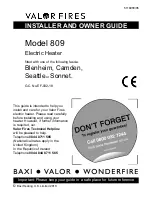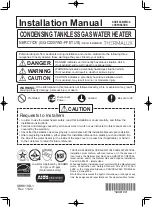
12
Installation & Operation Manual
4
Domestic side (tank) piping
Temperature & pressure (T&P) relief valve
For protection against excessive
temperatures
and pressure, install
temperature and pressure protective
equipment required by local codes.
This equipment shall not be less than a
combination temperature and pressure relief
valve certified by a nationally recognized
testing laboratory that maintains periodic
inspection of production of listed equipment
or materials as meeting the requirements for
Relief Valves and Automatic Gas Shutoff
Devices for Hot Water Supply Systems,
ANSI Z21.22 and the Standard CAN1-4.4,
Temperature, Pressure, Temperature and
Pressure Relief Valves and Vacuum Relief
Valves. The combination temperature and
pressure relief valve shall be marked with
a maximum set pressure not to exceed the
maximum working pressure of the water
heater. The combination temperature and
pressure relief valve shall also have an hourly
rated temperature steam BTU discharge
capacity not less than shown in Table 4A.
Install the combination temperature and
pressure relief valve into the opening
provided and marked for this purpose on
the water heater.
WARNING
NOTICE
Verify that the combination temperature
and pressure relief valve complies with local
codes. If the combination temperature and
pressure relief valve does not comply with
local codes, replace it with one that does.
Follow the installation instructions in this
section.
NOTICE
The Lochinvar SIT DW series water heaters
will absorb/store less than 200,000 Btu/hr when
domestic water outlet temperature is 210°F
and boiler water supply temperature is
240°F. Listed outputs are based on ASME
Section VIII Interpretation VIII-1-86-136.
Check with local codes for applicability.
Do not place a valve between the combination T&P relief valve
and the tank.
Determine T&P relief valve size by the following specifications,
unless they conflict with local codes:
-
SIT040/050DW - 3/4" NPT with a minimum CSA
Rating of 105,000 Btu/hr.
-
SIT065/080/119DW - 3/4" NPT with a minimum CSA
Rating of 200,000 Btu/hr.
Anti-scald valves (mixing valves)
Anti-scald valves used with water heaters are also called
tempering valves or mixing valves. An anti-scald valve
mixes cold water in with the outgoing hot water to assure
that hot water reaching a building fixture is at a temperature
low enough to be safe. ASSE1017 and ASSE1070 certified
valves are recommended.
Usually, the maximum temperature of the outlet water will
stay near the setting of the tank control. In some cases,
however, hot water usage patterns can cause the outlet
water temperature to rise significantly above the control
setting.
The temperature of water going to the fixtures may be
more carefully controlled through the use of a thermostatic
mixing valve. This device blends a controlled amount of
cold water with the hot water leaving the tank so that water
at a more constant temperature exits the mixing valve.
Anti-scald mixing valve piping is illustrated in FIG.’s 3-1
thru 3-4.
Install drain valve
Drain valve and fittings are supplied by others.
Standard Installation
•
Install a tee connection at the domestic cold water
inlet
(FIG.
4-1).
DRAIN
VALVE
Figure 4-1 Drain Valve Installed
WARNING
An anti-scald mixing valve does not
eliminate the risk of scalding.
*
Set the tank thermostat as low as
practical.
* Feel water before bathing or
showering.
*
If anti-scald or anti-chill protection
is required, use devices specifically
designed for such service. Install
these devices in accordance with
their manufacturer’s instructions.










































